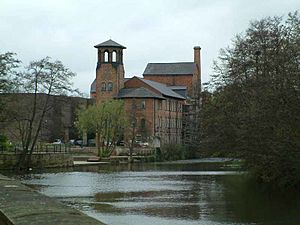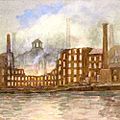Lombe's Mill facts for kids
Lombe's Mill was the first successful silk throwing mill in England. It was built on an island in the River Derwent in Derby. John Lombe traveled to Piedmont, a region in Italy, in 1717. There, he carefully studied the Italian machines used for making silk thread, called filatoio and torcitoio. When he returned to England, he brought some Italian experts with him and built the mill. George Sorocold was the person who designed the building.
Contents
Where Was Lombe's Mill Located?
Lombe's Mill was built right next to Thomas Cotchett's earlier mill from 1704. This was on the west bank of the River Derwent in Derby. A special wall, called a weir, had been built across the river there. The mill was placed on an island downstream. This island separated the main river from a smaller channel that powered three other mills. Derby was a great spot for the mill because the river flowed very fast. Also, the A6 road, which connected London to Carlisle, crossed the river at this point.
The Story of Lombe's Mill
- Further information: Derby Industrial Museum
This mill is very important because it was the first successful factory in England to make silk thread. It might even have been the first fully mechanized factory anywhere in the world!
Thomas Cotchett built an earlier mill in Derby in 1704, but it didn't work out well. So, in 1716, John Lombe went to Piedmont in Italy. He wanted to see how their successful silk mills worked. This trip was an early example of "industrial spying," where someone tries to learn secret manufacturing methods. John came back to Derby with this knowledge and a group of Italian workers.
He and his half-brother, Thomas Lombe, asked George Sorocold to build a mill based on John's designs. They then put the new machines inside. The mill was built just south of Cotchett's old mill. Thomas Lombe received a 14-year patent to protect the design of the silk-making machines. This meant no one else could copy them for 14 years.
The King of Sardinia, who ruled Piedmont, was not happy about this. He stopped sending raw silk to England. Some people think he might have been responsible for John Lombe's mysterious death six years later in 1722. After John's death, his older brother, Thomas Lombe, took over the business. When the patent ended in 1732, other silk mills started to appear in places like Stockport and Macclesfield. Before 1739, another building called the Doubling Shop was added north of the main mill. This shop didn't use water power. In 1739, the mill was sold to Thomas Wilson. We still have a list of everything in the mill from that time.
The Main Mill: The Italian Works
Most of the original mill building has been rebuilt over the years. Not much of the first structure remains today. However, old writings tell us it was a five-story building with a rectangular shape. It was about 17 meters (56 feet) tall, 33.5 meters (110 feet) long, and 12 meters (39 feet) wide. The roof was slightly sloped.
The mill was built from brick on top of stone arches. These arches allowed the River Derwent's water to flow underneath. The main silk-making machines were two stories high and were attached to the first floor. The winding machines were placed on the top three floors.
All the machines were powered by a large water wheel designed by Sorocold. This wheel was outside the mill. It was 7 meters (23 feet) across and 2 meters (6.5 feet) wide. Its main shaft entered the mill through a hole on the first floor. This shaft turned a vertical shaft, which was about 0.45 meters (1.5 feet) square. This vertical shaft then powered a horizontal shaft that ran the entire length of the mill. The torcitoios and filatoios machines got their power from this horizontal shaft. The vertical shaft also extended up to the top three floors to power the winding machines.
The mill needed to be warm to process the silk correctly. This was mentioned in the 1718 patent. In 1732, it was reported that Lombe used a "fire engine" (an early steam engine) to pump hot air around the mill. This helped keep the temperature high and even. The mill also had a stair column that was 19.5 meters (64 feet) tall, but we don't know exactly how it was laid out. There is also no information about how materials were moved between the different floors.
The Doubling Shop
The Doubling Shop was a separate building. It was three stories high and measured about 42.4 meters (139 feet) long by 5.5 meters (18 feet) wide. Each floor in this building was used for "doubling" silk threads. There were 306 doubling machines in total.
How Silk Thread Was Made
Around the year 1700, the Italians were the most advanced in Europe at making silk thread. They had invented two special machines. One machine, called a filatoio, wound the silk onto bobbins while adding a twist to the thread. The other machine, called a torcitoio, was used for "doubling" or twisting multiple threads together.
An old drawing from 1487 shows a circular, hand-powered machine for making silk thread with 32 spindles. The first proof of a filatoio powered by an outside source, like water, comes from the 13th century. The earliest drawing of such a machine is from around 1500.
Both the filatoios and torcitoios had parallel circular frames that spun around each other on a central pole. The speed at which they spun determined how much twist was put into the silk. Silk could only be processed well if the temperature and humidity were high. In Italy, the sun naturally provided this heat. But in Derby, the mill had to be heated, and the warmth needed to be spread evenly throughout the building.
Lombe's Mill Today
Over the years, the mill was owned by many different people and was rebuilt several times. However, the changed building still stands today. It has been restored and now houses the Derby Industrial Museum. You can also find a special sculpture of John Lombe nearby at Exeter Bridge.
Related Pages
- Bibliography
Images for kids
-
Watercolour by Alfred John Keene of the 1910 fire.
See also
 In Spanish: Molino de Lombe para niños
In Spanish: Molino de Lombe para niños





